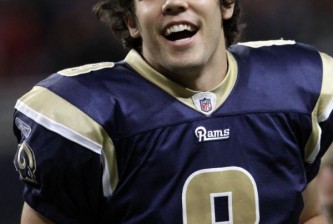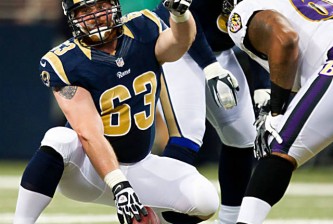As the St Louis Rams' record continues to slide following a heartening 3-2 start to the season, Sam Bradford's progression on the "elite quarterback growth curve" is receiving increasing scrutiny. Whether he has a strong game (275-2-0 versus the 49ers) or a weak one (170-2-1 vs the Jets), unless the Rams win the criticism will always be there. It's just a matter of volume.
It doesn't help that younger quarterbacks like Andy Dalton, Andrew Luck, and Robert Griffin III have stepped ahead of him in the public spotlight, nor does it help that Bradford signed the last of the big-money rookie contracts, a $79-million-dollar shadow that looms over his unimpressive win-loss total like the Sword of Damocles.
In fairness, none of those things are relevant to Bradford's growth as a quarterback or his ability to lead the Rams to the playoffs. All we can do is look at the hallmarks of his performance that are improving, or that still need to improve. And we can look to football history for comparables.
As it turns out, we don't have to look back too far to find a highly-paid #1 overall pick who struggled to live up to expectations through his first three years, and turned out okay. That is, if winning two Super Bowls and their corresponding MVP awards is okay.
Sam Bradford vs Eli Manning: a Statistical Comparison
| QB | GS | COMP | ATT | YARDS | COMP% | TD | INT | YD/ATT |
|---|---|---|---|---|---|---|---|---|
| Bradford 2010-12 | 36* | 747 | 1249 | 7918 | 58.7% | 36 | 29 | 6.2 |
| Manning 2004-06 | 37 | 690 | 1276 | 8049 | 54.1% | 54 | 44 | 6.3 |
*Through 10 games of 2012
For now, let's take wins out of the equation, since wins and losses are a 53-man calculation. If we just look at the statistics, we see two quarterbacks who have thrown almost exactly the same number of passes, with very similarly underwhelming results. Bradford has been more accurate, on balance, while Manning had more game-changing plays, both good and bad.
Arguably, on balance, both quarterbacks gave their teams a roughly equal chance of winning their games. Now, let's look at their QB records over that same span:
2010-12 Rams* (w/ Bradford): 11-24-1
2004-06 Giants (w/Manning): 20-19
The Giants, with Manning, were a picture of mediocrity in his first three years. And despite the team making the playoffs in year 2, the team was widely credited with getting there despite their quarterback, who completed only 52% of his passes. Moreover, their playoff visit was a short and unpleasant one, losing 23-0 to the Carolina Panthers on the Giants Stadium grass. Here was the media's perception of Manning's play in that 11-5 sophomore season:
And while Coughlin wants more from his quarterback than to be the offense's manager – "The quarterback's got to be a playmaker," he said – the statistics show that the Giants do not need Manning to win games as much as they need him to prevent losing them. – NYT, 2005
To make matters worse, the team took a step back in the standings in year 3, as Manning failed to take a perceived evolutionary step forward, and people began openly wondering whether trading away from Philip Rivers to take Manning was a mistake.
The cocoon from criticism has a way of wearing thin in Year 3, a sort of unwritten deadline for quarterbacks to turn potential into performance. It is a time when most highly drafted quarterbacks either continue to glide into the comfort of a distinguished career, or slip forever into the unforgiving realm of draft-day regrets. – NYT, 2006
As Giants fans continued to grumble restlessly and look wistfully at other quarterbacks' success, Eli continued to make maddeningly slow progress. Not knowing the radical step forward he was about to take in the 2007 playoffs, unseating four consecutive favored teams on the road including the almighty 18-0 Patriots, the media's criticism of Manning reached its heights that autumn:
“Whatever ‘It’ Is, Eli Is Without It,” read a headline over a column in The Record of Hackensack, N.J. A pair of Newsday reviews were topped with “Unfortunately, Eli’s as Good as He’s Going to Get,” and “Eli’s O.K. — That’s the Giants’ Problem.”
… Manning will never be a fiery leader, but he did not need to be if his play provided the talking. Now his growth curve has flattened, and he is having a season that is not appreciably different than the one before it, or the one before that. His key statistics — completion percentage, yards, touchdowns and interceptions — all fall in the category of average.
Average is not what the Giants hoped to have from Manning in his fourth season. – NYT, Nov 2007
In fact, he arguably did not become as polished a passer as Sam Bradford is now until his fifth season in the NFL. And mind you, this is with superior receiving talent and the benefit of a consistent offensive system throughout.
| QB | GS | COMP | ATT | YARDS | COMP% | TD | INT | YD/ATT |
|---|---|---|---|---|---|---|---|---|
| Bradford 2012 per game | 10* | 20.2 | 33.2 | 224.2 | 60.8% | 1.2 | 0.8 | 6.8 |
| Manning 2008 per game | 16 | 18.1 | 29.9 | 202.4 | 60.3% | 1.3 | 0.6 | 6.8 |
However, by this point Eli had delivered the hardware to New York, and his critics – even the ones that came from his own locker room, like Tiki Barber – were forced to admit that they had been wrong.
"In fairness to Barber, he wasn’t wrong, nor was he saying anything groundbreaking back then. At the time, there were a million doubters about Manning’s leadership abilities, including some of his bosses and some of his teammates. At the time, it was perfectly fair for a TV commentator to wonder out loud whether Manning would ever become the leader the Giants needed him to be."
In fact, all Eli has done from that point forward until now is get better, his recent "tired arm" aside. The 2007 playoffs were his watershed moment. Since that magical run, he has completed more than 60% of his passes in each of the following five seasons, cracked the 4000-yard mark three times, thrown 129 TDs against 76 INTs, and yes, even had his name mentioned in the "elite" conversation.
None of this is a guarantee that Sam will follow Eli's growth curve exactly, or that he will deliver multiple championships to St Louis. But it speaks eloquently to the fact that Bradford's play at this point in his career is far from the guarantee of long-term failure that his ardent critics like to think it is.
This comparison also points out the worthlessness of terms like "elite" when evaluating QB play. Bottom line: Bradford has to play well enough to give his team a chance to win consistently, week after week. Manning learned how to do that over time. If Bradford continues his growth, and the team continues to stock the team with talent on both sides of the ball, he will too.























